JAPANESE / ENGLISH

JAPANESE / ENGLISH
Last updated on 03/8/2023
Fiber-optic communication is mainly conducted in the wavelength region where optical fibers have small transmission loss. This low-loss wavelength region ranges from 1260 nm to 1625 nm, and is divided into five wavelength bands referred to as the O-, E-, S-, C- and L-bands, as shown in Figure 1 and 2.

Figure 1: Transmission loss of silica fiber and optical communication wavelength bands.

Figure 2: Electromagnetic spectrum & optical communication wavelength bands.
Among these five bands, the O-band (orignal band: 1260-1360 nm) was historically the first wavelength band used for optical communication, because signal distortion (due to chromatic dispersion) is minimum. It was also because optical fibers produced in the mid 1970s showed its lowest loss near the O-band.
Today optical fibers show its lowest loss in the C-band, and thus is commonly used in many metro, long-haul, ultra-long-haul, and submarine optical transmission systems combined with the WDM and EDFA technologies.
The L-band is the second lowest-loss wavelength band, and is a popular choice when the use of the C-band is not sufficient to meet the bandwidth demand. The same WDM and EDFA technologies can be applied to the L-band. Repeatered C+L-band WDM transmission is now commercially feasible, and is employed even for transoceanic submarine transmission systems (see here).
The loss of optical fiber in the S-band (short-wavelength band: 1460-1530 nm) is lower than that of the O-band, and the S-band is used for many PON (Passive-Optical Network) systems as the downstream wavelength. The S-band is also gathering attention for DWDM transmission as a future R&D topic, further extending the bandwidth of terrestrial optical network beyond the C+L-band.
The E-band (extended-wavelength band: 1360-1460 nm) is the least common wavelength band among the five. This is because the attenuation of early optical fiber in the E-band was highest among the five bands, due to residual water (OH group) impurity remained in the glass. After the invention of dehydration technique during glass production, the attenuation of most commonly used optical fiber (ITU-T G.652.D) in the E-band has become lower than that in the O-band. The use of the E-band in optical communication is, nevertheless, still limited as many existing fiber optic cables installed before 2000 show high attenuation in the E-band.
In addition to the O- to L-bands, there are two more wavelength bands, namely the 850-nm-band and U-band (ultra-long-wavelength band: 1625-1675 nm). The 850-nm-band is the primary wavelength for multimode fiber optical communication systems, combined with VCSEL (Vertical-Cavity Surface Emitting Laser). The U-band is mainly used for network monitoring purposes.
Though various wavelength bands of the O-, S-, C- and L- bands have come into use with the explosive expansion of internet traffic in recent years, optical fiber amplifiers for the O- and S-band wavelengths were not realized for many years because of many technical hurdles.
With the original fluoride fiber technology, FiberLabs has successfully developed optical fiber amplifiers for the O- and S-bands and 850 nm of wavelengths. With world-leading optical amplification technology, FiberLabs presently provides optical amplifiers of a variety of wavelength bands, including 850nm-, 980 nm-, 1030nm-, O-, S-, C-, L-, CL-, and SCL-bands.
| 850-nm-band | O-band | S-band | C-band | L-band | C+L-band | S+C+L-band | Full-band (O/E/S/C/L) | |
|---|---|---|---|---|---|---|---|---|
| Fiber amplifier | Bench-top | Bench-top Rack-mount OEM Module | Bench-top Rack-mount OEM Module | Bench-top Bench-top, HP Rack-mount OEM Module | Bench-top Bench-top, HP Rack-mount OEM Module | Bench-top 4-λ CWDM (rack-mount) Unidirectional BiDi, Booster BiDi, In-line | 8-λ CWDM (rack-mount) Unidirectional | N/A |
| ASE source | Bench-top | Bench-top OEM module | Bench-top OEM module | Bench-top OEM module | Bench-top OEM module | Bench-top OEM module | Bench-top | N/A |
| SLD source | Bench-top OEM module | Bench-top | ||||||
| LD source | Bench-top (Fabry-Perot) Bench-top (DFB) Bench-top (FBG-stabilized) | N/A | N/A | N/A | ||||
| Tunable filter | N/A | Bench-top | N/A | N/A | ||||